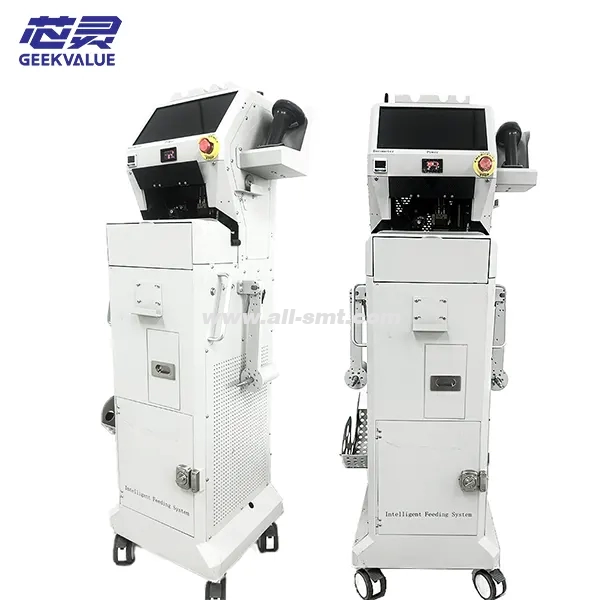އެންޓި މިކްސިން އެސްއެމްޓީ އޮޓޮމެޓިކް މެޓީރިއަލް ރިސީވިން މެޝިނަކީ އެސްއެމްޓީ ޕެޗް ޕްރޮޑަކްޝަން ލައިންތަކުގައި ބޭނުންކުރާ އިންޓެލިޖެންޓް ޑިވައިސްއެކެވެ. މިއީ މައިގަނޑު ގޮތެއްގައި އޮޓޮމެޓިކް މެޓީރިއަލް ރިސީވްކުރުމާއި، މެޓީރިއަލް މިކްސްވުން ހުއްޓުވުމާއި، ޕްރޮޑަކްޝަން ކޮންޓިނިއުޓީއާއި މެޓީރިއަލް އެކިއުރެސީ ކަށަވަރުކުރުމަށް ބޭނުންކުރާ އެއްޗެކެވެ. އޮޓޮމެޓިކް މެޓީރިއަލް ރިސީވިން ޓެކްނޮލޮޖީ އާއި އެންޓި މިކްސިން މެނޭޖްމަންޓް ސިސްޓަމް އިންޓަގްރޭޓްކޮށްފައިވާ މި ޑިވައިސް އަކީ ކޮންސިއުމަރ އިލެކްޓްރޯނިކްސް، އޮޓޯމޯޓިވް އިލެކްޓްރޯނިކްސް، އަދި މެޑިކަލް އިކުއިޕްމަންޓްސް ފަދަ ހައި ޕްރެސިޝަން ޕީސީބީ އެސެމްބްލީ ދާއިރާތަކުގައި ގިނައިން ބޭނުންކުރާ ޑިވައިސްއެކެވެ.
2. މައިގަނޑު ފަންކްޝަންތައް
(1) އޮޓޮމެޓިކް މެޓީރިއަލް ރިސީވިންގ ފަންކްޝަން
ނޮން ސްޓޮޕް މެޓީރިއަލް ޗޭންޖް: ޕްރޮޑަކްޝަން ލައިން މެދުކެނޑުމެއް ނެތި މެޓީރިއަލް ޓޭޕް ބޭނުން ކުރުމުގެ ކުރިން އޮޓޮމެޓިކުން މެޓީރިއަލްސް ހޯދައި މެޓީރިއަލްސް ރިސީވް ކުރުން.
ހައި-ޕްރެސިޝަން މެޓީރިއަލް ރިސީވިންގ: މެޓީރިއަލް ޓޭޕް ރިސީވިންގ އެކިއުރެސީ (±0.1އެމްއެމް ގެ ތެރޭގައި) ޔަގީންކުރުމަށްޓަކައި ސަރވޯ މޯޓަރ + އޮޕްޓިކަލް އެލައިންމަންޓް އެޑޮޕްޓްކުރުން.
ގިނަ މެޓީރިއަލް ރިސީވް ކުރުމުގެ ގޮތްތައް: ސަޕޯޓް ޓޭޕް ބޮންޑިންގ، ހޮޓް ޕްރެސް ވެލްޑިންގ، އަލްޓްރާސޮނިކް ވެލްޑިންގ ފަދަ ކަންކަން.
(2) އެންޓި މިކްސިންގ ފަންކްޝަން
ބާކޯޑް/އާރްއެފްއައިޑީ ސްކޭނިންގ: މެޓީރިއަލް ޓްރޭގައި ހުންނަ ބާކޯޑް ނުވަތަ އާރްއެފްއައިޑީ ޓެގް އޮޓޮމެޓިކުން ކިޔައިގެން މެޓީރިއަލް މައުލޫމާތު (ޕީއެން ކޯޑް، ބެޗް، ސްޕެސިފިކޭޝަން ފަދަ) ޔަގީންކުރުން.
ޑޭޓާބޭސް އަޅާކިޔުން: އާ މެޓީރިއަލް ޓޭޕް މިހާރު އުފައްދާފައިވާ ބީއޯއެމް އާއި އެއްގޮތްވާތޯ ބެލުމަށް އެމްއީއެސް/އީއާރުޕީ ސިސްޓަމާ ގުޅާށެވެ.
އާދަޔާ ހިލާފު އެލާމް: ތަކެތި ނުގުޅޭނަމަ ވަގުތުން މެޝިން ހުއްޓި، ގޯސް ތަކެތި އުފެދުމުގެ ނުރައްކަލުން ސަލާމަތްވުމަށް އޮޕަރޭޓަރަށް ބާރުއަޅާނެއެވެ.
(3) އިންޓެލިޖެންޓް މެނޭޖްމަންޓް ފަންކްޝަން
ޑޭޓާ ޓްރޭސެބިލިޓީ: ޕްރޮޑަކްޝަން ޓްރޭސެބިލިޓީއަށް އެހީތެރިވުމަށްޓަކައި މެޓީރިއަލްސް، އޮޕަރޭޓަރުން، މެޓީރިއަލް ބެޗްސް އަދި އެހެނިހެން މައުލޫމާތު ލިބޭ ވަގުތު ރެކޯޑްކުރުން.
ރިމޯޓް މޮނިޓަރިންގ: އައިއޯޓީ ނެޓްވޯކިންގ އަށް ސަޕޯޓްކޮށް، ރިއަލް ޓައިމްގައި އިކުއިޕްމަންޓް ސްޓޭޓަސް އެމްއީއެސް ސިސްޓަމަށް އަޕްލޯޑް ކުރުން.
އޮޓޮމެޓިކް އިންޒާރު: މެޓީރިއަލް ބެލްޓް ހުސްވާން އުޅޭއިރު، މެޓީރިއަލް ކަނެކްޝަން އާދަޔާ ހިލާފުވެފައި ނުވަތަ މެޓީރިއަލްތައް އެއްގޮތް ނުވާ ވަގުތުތަކުގައި އެލާމް ޓްރިގަރ ކުރާށެވެ.
3. އިކުއިޕްމަންޓް ކޮމްޕޮޒިޝަން
މޮޑިއުލް ފަންކްޝަން ޑިސްކްރިޕްޝަން
މެޓީރިއަލް ބެލްޓް ކޮންވެޔަރ މެކޭނިޒަމް އައު އަދި ކުރީގެ މެޓީރިއަލް ބެލްޓް ޞަރީޙަކޮށް ދަމައިގަނެގެން އޮމާންކަމާއެކު ކާން ދިނުން ކަށަވަރުވެއެވެ
އޮޕްޓިކަލް ޑިޓެކްޝަން ސިސްޓަމް މެޓީރިއަލް ބެލްޓްގެ ޖާގައާއި ފުޅާމިން ދެނެގަނެ، މެޓީރިއަލް ކަނެކްޝަންގެ ފެންވަރު ދެނެގަނެވޭނެއެވެ
ބާކޯޑް/އާރުއެފްއައިޑީ ސްކޭނިންގ ހެޑް މެޓީރިއަލް މައުލޫމާތު ކިޔައި، ގޯސް މެޓީރިއަލްސް ހުރިތޯ ބެލުން
މެޓީރިއަލް ކަނެކްޝަން ޔުނިޓް މެޓީރިއަލް ގުޅުވުމަށް ޓޭޕް/ހޮޓް ޕްރެސިންގ/އަލްޓްރަސޮނިކް މެތެޑެއް ބޭނުންކުރެއެވެ
ކުނި ރިކަވަރީ ޑިވައިސް އޮޓޮމެޓިކުން މެޓީރިއަލް ބެލްޓް ޕްރޮޓެކްޓިވް ފިލްމް ފަޅައިގެން ގޮސް ރިކަވަރ ކޮށްދެއެވެ
ޕީއެލްސީ/އިންޑަސްޓްރިއަލް ކޮންޓްރޯލް ސިސްޓަމް އިކުއިޕްމަންޓްގެ އޮޕަރޭޝަން ކޮންޓްރޯލްކޮށް އެމްއީއެސް ސިސްޓަމާ ގުޅެއެވެ
އެޗްއެމްއައި ހިއުމަން-މެޝިން އިންޓަރފޭސް މެޓީރިއަލް ރިސީވިންގ ސްޓޭޓަސް އަދި އެލާމް މައުލޫމާތު ދައްކާ، އަދި ޕެރެމިޓަރ ސެޓިންގ އަށް ސަޕޯޓް ކުރެއެވެ
4. ވޯކްފްލޯ
މެޓީރިއަލް ބެލްޓް ޑިޓެކްޓްކުރުން: މި ސެންސަރުން މެޓީރިއަލް ބެލްޓްގައި މިހާރު ބާކީ ހުރި މިންވަރު މޮނިޓަރކޮށް ރިސީވިންގ ސިގްނަލް ޓްރިގަރ ކުރެއެވެ.
އާ މެޓީރިއަލް ޓޭޕް ތައްޔާރުކުރުން: މި އިކުއިޕްމަންޓުން އޮޓޮމެޓިކުން އާ މެޓީރިއަލް ޓްރޭތަކަށް ފީޑްކޮށް، ބާކޯޑް/އާރުއެފްއައިޑީ ސްކޭންކޮށް މެޓީރިއަލް މައުލޫމާތު ޔަގީންކުރެއެވެ.
އެންޓި-ރޮންގް މެޓީރިއަލް ވެރިފިކޭޝަން: އެމްއީއެސް ޑޭޓާ އަޅާކިޔައި، މެޓީރިއަލް ރަނގަޅުކަން ކަށަވަރުކޮށް، މެޓީރިއަލް ކަނެކްޝަން ޕްރޮސެސްއަށް ވަނުން.
ޞައްޙަ ގުޅުން:
މުސްކުޅި މެޓީރިއަލް ޓޭޕް ކަނޑާލުމަށްފަހު އާ މެޓީރިއަލް ޓޭޕާ އެއްވަރުކޮށްލާށެވެ
ކަނެކްޝަން/ހޮޓް ޕްރެސް ކުރުން
ކަނެކްޝަންގެ ޞައްޙަކަން ޔަޤީންކުރުމަށްޓަކައި އޮޕްޓިކަލް އިންސްޕެކްޝަން ހެދުން
ކުނި ހޯދުން: ޕްލޭސްމަންޓް މެޝިންގެ ނޮޒެލް އަށް ހުރަސް އެޅުމަށްޓަކައި ކުނި ޓޭޕް އޮޓޮމެޓިކުން ފޮޅާލާށެވެ.
މެދުނުކެނޑި އުފެއްދުން: ސީމްލޭސް ކަނެކްޝަން، މުޅި ޕްރޮސެސްގައި މެނުއަލް އިންޓަރވެންޝަން ބޭނުން ނުވާނެއެވެ.
5. ފަންނީ ފައިދާތައް
އެޑްވާންޓޭޖް ޑިސްކްރިޕްޝަން
100% އެރަރ ޕްރިވެންޝަން: ބާކޯޑް/އާރްއެފްއައިޑީ+އެމްއީއެސް ޑަބަލް ވެރިފިކޭޝަން، އިންސާނީ ގޯސްތައް ނައްތާލުން
މަތީ ޕްރޮޑަކްޝަން އެފިޝަންސީ: މެޓީރިއަލް ބަދަލުކުރުމަށް ހުއްޓާލަން ނުޖެހޭ، ޑައުންޓައިމް މަދުކޮށް، އޯވަރޯލް އިކުއިޕްމަންޓް އެފިޝަންސީ (އޯއީއީ) ރަނގަޅުކުރުން
ހައި-ޕްރެސިޝަން ސްޕްލައިސިންގ: ±0.1އެމްއެމް ސްޕްލައިސިންގ އެކިއުރެސީ، 0201 އަދި 0402 ފަދަ ކުދި ކޮމްޕޯނެންޓްތަކުގެ ސްޓެބިލިޓީ ކަށަވަރުކޮށްދެއެވެ
އިންޓެލިޖެންޓް މެނޭޖްމަންޓް: ޕްރޮޑަކްޝަން ޑޭޓާގެ ޓްރޭސެބިލިޓީ ހޯދުމަށް އެމްއީއެސް/އީއާރުޕީ ޑޮކިންގ އަށް ސަޕޯޓްކުރުން
ވަރުގަދަ ކޮމްޕެޓިބިލިޓީ: 8އެމްއެމް، 12އެމްއެމް، އަދި 16އެމްއެމް ފަދަ ތަފާތު ފުޅާމިނުގެ ސްޓްރިޕްތަކަށް އެޑެޕްޓް ވެވޭނެއެވެ
6. އެޕްލިކޭޝަންގެ މަންޒަރުތައް
ކޮންސިއުމަރ އިލެކްޓްރޯނިކްސް: މޯބައިލް ފޯނު، ޓެބްލެޓް، ސްމާޓް ވެއަރބަލް ޑިވައިސް ފަދަ ތަކެތި ގިނަ އަދަދަކަށް އުފެއްދުން.
އޮޓޯމޯޓިވް އިލެކްޓްރޯނިކްސް: އޮޓޯމޯޓިވް ގްރޭޑް ޕީސީބީ އެސެމްބްލީ، މެޓީރިއަލް އެކިއުރެސީއަށް އިންތިހާއަށް މަތީ ޝަރުތުތަކެއް އެކުލެވިގެންވެއެވެ
މެޑިކަލް އިކުއިޕްމަންޓް: އިންތިހާއަށް މަތީ އިތުބާރު ކުރެވޭ ގޮތަށް ޕްރެސިޝަން އިލެކްޓްރޯނިކް ކޮމްޕޯނެންޓްތައް އުފެއްދުން
އަސްކަރީ ސިނާއަތް/އެއަރޮސްޕޭސް: މިކްސްޑް މެޓީރިއަލްސްގެ ނުރައްކަލުން ސަލާމަތްވުމަށްޓަކައި މެޓީރިއަލް ބެޗްތައް ހަރުކަށިކޮށް ކޮންޓްރޯލްކުރުން
7. މާކެޓުގައި މެއިންސްޓްރީމް ބްރޭންޑްތައް
ބްރޭންޑް ފީޗާސް
އޭއެސްއެމް ހައި ޕްރެސިޝަން، ސްމާޓް ފެކްޓްރީ އިންޓަގްރޭޝަން އަށް ސަޕޯޓް ކުރެއެވެ
ޕެނަސޮނިކް ސްޓޭބަލް އަދި އިތުބާރު ކުރެވޭ، އޮޓޯމޯޓިވް އިލެކްޓްރޯނިކްސް އަށް އެކަށީގެންވާ
ޖޫކީ ޚަރަދު ކުޑަ، ކުދި އަދި މެދުފަންތީގެ ވިޔަފާރިތަކަށް އެކަށީގެންވާ
YAMAHA ވަރުގަދަ ފްލެކްސިބިލިޓީއެއް، ފަސްޓް ލައިން ޗޭންޖް އަށް ސަޕޯޓް ކުރެއެވެ
ގޭތެރޭގެ ސާމާނު (ޖިންޓޫއޯ، ޖީކޭޖީ ފަދަ) އަގުހެޔޮ، ރަނގަޅު ލޯކަލައިޒްޑް ޚިދުމަތެއް
8. ކުރިއަށް އޮތް ތަރައްޤީގެ ޓްރެންޑްސް
އެއައި+މެޝިން ވިޝަން: މެޓީރިއަލް ޑިފެކްޓްސް އޮޓޮމެޓިކުން ޑިޓެކްޓްކޮށް ސްޕްލައިސިންގ ކޮލިޓީ އޮޕްޓިމައިޒް ކުރުން.
އިންޓަރނެޓް އޮފް ތިންގްސް (އައިއޯޓީ) އިންޓަގްރޭޝަން: އިކުއިޕްމަންޓް ސްޓޭޓަސް އަދި ޕްރިޑިކްޓިވް މެއިންޓެނަންސް ރިއަލް ޓައިމް މޮނިޓަރިންގ.
މިއަށްވުރެ ފްލެކްސިބަލް ޑިޒައިން: ކުދި ބެޗްތަކާއި އެތައް ވައްތަރެއްގެ ފަސްޓް ލައިން ބަދަލުކުރުމުގެ ބޭނުންތަކަށް އެޑެޕްޓްވުން.
ފެހި އުފެއްދުންތެރިކަން: ޓޭޕް/ކުނި ބޭނުންކުރުން މަދުކޮށް، ތިމާވެށި ރައްކާތެރިކުރުން ރަނގަޅުކުރުން.
9. ޚުލާޞާ
އެސްއެމްޓީ އޮޓޮމެޓިކް އެރަރ ޕްރޫފިންގ މެޓީރިއަލް ރިސީވިންގ މެޝިނަކީ ހައި ޕްރެސިޝަން އަދި ވަރަށް އިންޓެލިޖެންޓް އެސްއެމްޓީގެ އެހީތެރި އިކުއިޕްމަންޓެކެވެ. އޮޓޮމެޓިކް މެޓީރިއަލް ރިސީވިންގ + އެރަރ-ޕްރޫފިންގ ވެރިފިކޭޝަން މެދުވެރިކޮށް، އުފެއްދުމުގެ ރަނގަޅުކަން ވަރަށް ބޮޑަށް ރަނގަޅުވެ، އިންސާނީ ގޯސްވުމުގެ ނުރައްކާ ކުޑަވެގެންދެއެވެ. އިލެކްޓްރޯނިކް އުފެއްދުންތެރިކަން އިންޓެލިޖެންސް އާއި އިންސާނުން ނެތް ގޮތަށް ތަރައްގީވަމުންދާއިރު، މި އިކުއިޕްމަންޓް ވެގެންދާނީ އެސްއެމްޓީ ޕްރޮޑަކްޝަން ލައިންތަކުގެ މުހިއްމު ބަޔަކަށެވެ.







